People And Canines
What Is Flyball?

Flyball is a relay racing sport involving a team of four dogs and handlers. The dogs take turns racing over four hurdles, ten feet apart in distance from each other, to a spring-loaded box which shoots out a tennis ball when the dog triggers the box with it's feet. The dog then grabs the tennis ball (right outta the air!) and races back across all four hurdles, passing the next dog in line at full speed, to return to it's handler and receive a treat or reward for doing a good job.
Each of the four dogs has to execute their runs flawlessly...no passing each other early before the start line, no skipping hurdles, no chasing the dog in the other lane, no dropping the ball, the box must be correctly triggered, etc. If a mistake is made during the run, the dog is made to run it all over again - which hurts timing and placement, and usually ends in a heat loss.
"Heat"? Yeah...in a tournament, a heat is when all four dogs on a team complete a single run. A race is a series of heats run back-to-back to determine a winner, as in best three heats out of five.
Sound confusing? It's really not...
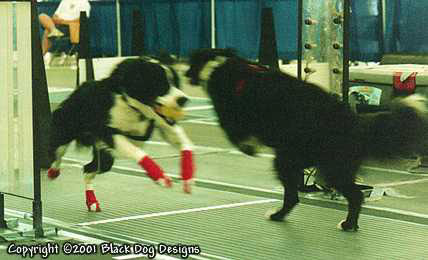 (LEFT: Two dogs execute an ideal pass during racing - the dog with the ball in it's mouth is returning, the dog it is passing is going to retreive a ball. The line below them is the start line, and the upright standards to either side of them are the sensors for the Electronic Judging System. These two dogs race on Lone Star Ruffnecks in Houston, TX.)
(LEFT: Two dogs execute an ideal pass during racing - the dog with the ball in it's mouth is returning, the dog it is passing is going to retreive a ball. The line below them is the start line, and the upright standards to either side of them are the sensors for the Electronic Judging System. These two dogs race on Lone Star Ruffnecks in Houston, TX.)The dog teams are timed with an EJS, or Electronic Judging System. A single dog's "split" time (the time it takes to pass the start line, go over the hurdles, trigger the box, grab the ball, return over the hurdles, and pass the start line again) can be as fast as four seconds for the fastest dogs. An entire team of four dogs can execute the entire race in as fast as under twenty seconds...Top Dog Racers of Dallas, Texas, set a new record on March 31, 2001 of 16.11 seconds. Rocket Relay, from Canada, broke the 16-second time barrier by running a race in 15.88 seconds on August 19, 2001.
*wow* (To see a listing of World Rankings click here)
Of course, these teams that are breaking records worked very, very hard to get to that point and are examples of the fastest teams in the world.
BELOW: A typical tournament two-lane set up. Memphis, Tennessee
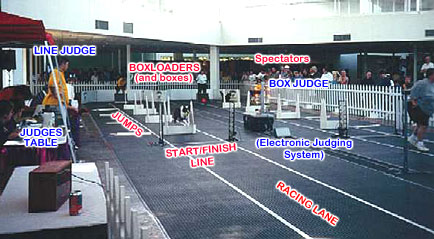
At a tournament, flyball teams are separated into groups, or Divisions, that allow the teams to race others of their same experience/speed level. Division 1 consists of the fastest teams in the region for that tournament, Division 2 (you might say) are the next fastest group, and so on...there can be as many as ten Divisions or more at any given tournament.
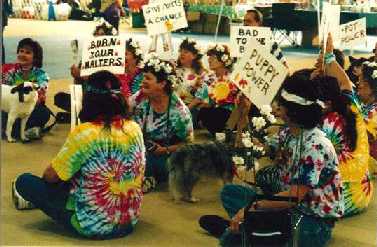 (RIGHT: Tournaments usually have themes,
(RIGHT: Tournaments usually have themes, and it can be a lot of fun to get into the spirit
of the tournament theme. Here, a team enjoys
having a "sit in" demonstration during
Hippie Hounds 2001.)
Teams are placed into Divisions based on a "seed time" that the captain of each team submits to the tournament director several weeks prior to the tournament. The seed time is a time that is supposed to be representative of the best time a team's racing line-up can perform on average.
Every Division except Division 1 has something called a "break-out time". A break-out time is a time set for that division that the teams within CANNOT run faster than. If a break-out time for a certain division is set at 22.75 seconds, and a team within that division runs a heat in 22.5 seconds, they've just "broken out" - or shown that they perhaps should have been placed in a higher division. A team is allowed to break out twice in one tournament. If it breaks out three times, it is no longer allowed to run for tournament points or compete in the tournament. This is how the racing is kept fair. The break-out time is usually set one second faster than a Division's fastest team's seed time.
Confused again? Head spinning? Good - we're on the right track, then.
A head judge oversees the activities of a tournament, and makes the final call on everything. He or she can't see everything all by themselves, though - so there are people assigned box judging and line judging duties. Box judges and line judges watch just those items during racing - and if they see a discrepency in the racing at the station they are monitoring, they raise a flag so that the head judge can spot where a mistake may have just occured.
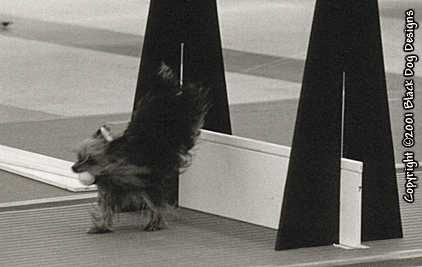 (RIGHT: A very tiny height dog:
(RIGHT: A very tiny height dog: Prissy, from Just Say Go!.)
Each team of dogs *ideally* will consist of six dogs, although only four race at a time. This team will have speed dogs (chosen for how fast they are) and height dogs (chosen for how small they are). The hurdles a team jumps to race are set based on the height of the shortest dog on the team - that is racing at that time. The shorter the hurdles, the faster the speed dogs. Of the six dogs on the team, again ideally, four will be speed dogs, and two will be height dogs. That way, during a tournament, dogs can be switched out in case of accident or to rest a tired racer and replace him/her with a fresh one.
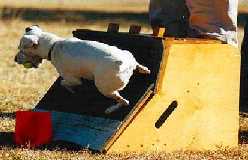 (LEFT: A Jack Russell on Texas Heat in Dallas, shows a really nice box-turn at practice, over an orange cone thingy. Observe the knees of the boxloader.)
(LEFT: A Jack Russell on Texas Heat in Dallas, shows a really nice box-turn at practice, over an orange cone thingy. Observe the knees of the boxloader.)A team would not be complete without the boxloader - this is the person that knows the team dogs well enough that he/she can load the proper sized ball in the box during the races (yeah - they come in sizes), which hole on the box the ball goes into for which dog, and all the dogs' names - to urge the dogs to "COME GET THE BALL!" as fast as they can. The boxloader has to be both fast and patient, as well as very, very observant...sometimes team dogs are switched around during a race and the team may forget to inform the boxloader (waaay down at the end of the track), who must divine by observation during a split-second glance who is racing next, which ball they use, and what hole the ball loads into. If a ball is loaded into a hole the dog is not accustomed to retreiving from, it can mess up the whole heat.
The boxloader must also know the correct rules for behaviour during a race, as in what to do when the box malfunctions, or when a dog decides to not do it's job. Mistakes by the boxloader can cost his/her team a heat.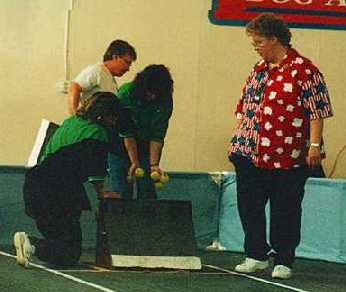

Incredible people, those boxloaders. They even win ribbons just as the team dogs do!
----------------------------
For more information on flyball, please see our LINKS page!
(RIGHT: P.A.C. experiences box problems,
and tournament head judge Val Culpin
-at far right- inspects the box to determine
whether it is actually box malfunction
or loader error.)